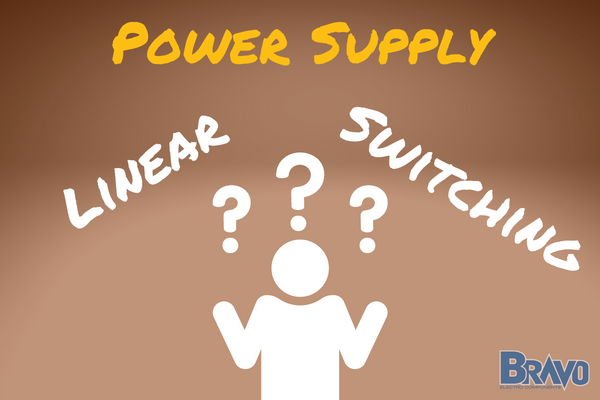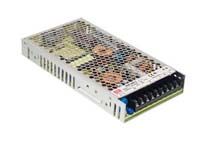
When searching for the ideal energy source for any system you need to power, you have two main options: linear vs switching power supply.
So what’s the difference between a linear and switching power supply, and which is right for your unique needs? Each has its own unique advantages and disadvantages that are important to consider when choosing the best power supply.
But, this decision can get overwhelming - particularly for those who aren’t power supply savvy. Fortunately, we are - and we’re here to unpack everything you need to know. Here are the key takeaways on this switching power supply vs linear power supply comparison:
- Switching power supplies are more efficient and compact. This comes at the cost of more noise. You’ll find these in manufacturing, aviation, and other industries.
- Linear power supplies have a quicker response to fluctuations in load. They’re quieter, but less efficient and a bit larger. Common in communications, medical equipment, and laboratory devices.
- Output power scale influences cost. Linear is more economical at smaller outputs, whereas switching is less expensive at higher loads.
That being said there’s more that goes into choosing between a switching vs non switching power supply - accounting for noise, understanding circuit complexity, and other factors. We’re here to simplify everything for you.
Discover the differences between a switching vs linear power supply and see which is better. Better yet, connect with our customer service team at Bravo Electro for the best selection of AC DC power supplies and DC converters - backed by world-class customer service every step of the way.
What’s the Difference Between a Linear vs Switching Power Supply?
So what’s the difference between a switching power supply vs linear power supply?
When looking to power your devices, linear and switching are the two main types of power supplies available. Both work by converting AC or DC mains electricity into a low-voltage form that those gadgets can use; however, their efficiency, cost, size, and performance vary drastically.
What is a Linear Power Supply and How Does it Work?
Linear power supplies use a transformer to decrease the input voltage until it reaches the preferred level and then smooth out any extra energy by using a series-pass transistor that dissipates this excess in heat form.
Voltage regulation within these linear types of power is attained by modifying the resistance of the particular transistors, so as to keep an even voltage across itself at all times.
Linear power supplies offer benefits such as low output ripple and noise levels that make them the perfect choice for high-precision applications that require minimal sound.
Nevertheless, their efficiency is lower than switching power supplies since they dissipate surplus energy in the form of heat. This can lead to bulky and heavier units - an issue when space is limited.
What is a Switching Power Supply and How Does it Work?
Switching power supplies utilize a high-frequency switch circuit that modulates the input voltage on and off at an incredibly rapid rate in order to generate your desired level of output voltage.
And with this technology comes tremendous power supply efficiency gains - since they don't waste extra electricity by converting it into thermal energy like their linear counterparts do. Switching power supplies are truly revolutionary devices that can help cut manufacturing costs while providing superior performance.
Switching power supplies are ideal for applications where there is limited space because they are smaller and lighter than linear power supplies. Plus, their higher efficiency means that they’re more cost-effective in the long run.
On the other hand, switching power supplies tend to generate more noise and ripple in their output voltage than linear power supplies. This poses an issue for applications that necessitate high precision or low noise.
Moreover, these types of power supplies usually require additional components and can be relatively difficult to set up for beginners.
Linear vs Switching Power Supply: Which is Better?
So which is better linear or switching power supply? When it comes to recognizing the best power supply for your specific application, there is no one-size-fits-all solution.
Choosing between a switching power supply vs linear power supply can be tricky due to the advantages and disadvantages of each type of device - meaning that you must consider all factors before determining which option will yield optimal performance.
Pros and Cons of Linear Power Supplies
Pros:
- Low output ripple and noise, making them well-suited for applications that need high precision and low noise.
- A straightforward design with fewer components leads to more reliability and simpler repair.
- Lower price tag for lower power requirements.
Cons:
- May not be as efficient as switching power supplies, resulting in more heat generation and bigger size.
- Limited power output, making them unsuitable for higher power needs.
- Power supply voltage regulation may not be as precise, necessitating larger and pricier components.
Pros and Cons of Switching Power Supplies
Pros:
- Higher efficiency, resulting in less heat dissipation and smaller size.
- Higher power output, making them suitable as high-voltage power supplies for larger applications
- Lower cost for high-power applications.
Cons:
- Can introduce more noise and ripple into the output voltage than linear power supplies.
- Higher cost for low-power applications.
Key Applications for Linear and Switching PSUs
When it comes to high-power applications that call for both efficiency, compactness, and affordability, switching power supplies are typically the superior choice. Such applications range from computers to consumer electronics and telecommunications equipment.
Linear power supplies are the optimal choice for low-power needs where you want minimal noise, the utmost precision, and a convenient layout. These types of applications include audio systems, medical equipment measurements, and test instruments.
So, Which is Better: Switching vs Linear Power Supply?
So when comparing linear vs switching power supply, which is better?
Overall, switching power supplies are generally the better choice for most applications due to their higher efficiency, smaller size, and lower cost for high-power applications.
However, for low-power applications that require low noise and high precision, a linear power supply may be the better choice.
Get Efficient, Long-Lasting Switching Power Supplies at Bravo Electro!
Now that we've discussed linear vs switching power supply in detail, you can confidently make the right choice for your specific application.
Bravo Electro is your trusted source for high-quality and efficient AC DC power supply. We partner with only the best of the best manufacturers and staff on-site engineers to provide a streamlined shopping experience.
Our salespeople are experts and can help you find exactly what you need. Even if you have no idea what type of power supply you need, we can help.
We offer competitive pricing and fast delivery for domestic orders, plus all of our products come with a manufacturer's warranty. It's all part of our top-rated customer service experience designed to make your shopping experience easy and enjoyable. The better question is why wait?
Whether you are looking for an enclosed power supply, open frame power supply, DIN rail power supply, modular power supply, or LED driver power supply, we have it all.
Other companies simply lack the selection that we have. And the quality of our power supplies can’t be matched. Experience the Bravo Electro difference today!
Wrapping Up Our Switching vs Linear Power Supply Comparison
With today's technology, both linear and switching power supplies come with their own unique set of advantages and disadvantages. Hopefully, you have a clear understanding of which is right for you between a switching vs linear power supply now.
So, what’s the difference between a linear and switching power supply? And which is better? When considering which type of power supply to use for your specific application, take into consideration power requirements, noise level, size, and cost.
Overall, switching power supplies are usually the better choice for most applications due to their higher efficiency, smaller size, and lower cost.
We understand that choosing the right power supply can be a tricky task. That's why we carry a variety of 12V power supplies, 24V power supply, and even 48V power supply to suit your needs
And as we said earlier, our salespeople and engineers are always available to answer any questions you might have and provide expert advice so you get a reliable and quality product for your project. So if you’re still struggling to choose between a switching power supply vs linear, get in touch today and we’ll point you in the right direction!









